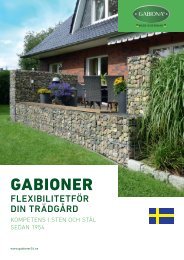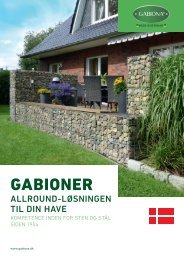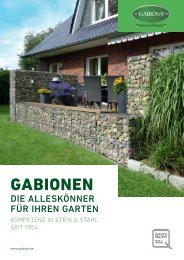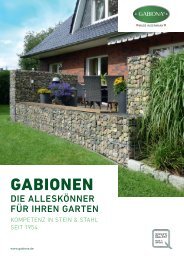Gabionen Katalog EN
- No tags were found...
You also want an ePaper? Increase the reach of your titles
YUMPU automatically turns print PDFs into web optimized ePapers that Google loves.
8<br />
?<br />
FAQS<br />
FREQU<strong>EN</strong>TLY ASKED QUESTIONS<br />
?<br />
WHAT IS THE RIGHT WAY TO FILL THE GABIONS?<br />
After inserting the spacers, first place wooden slats over them to protect them from falling<br />
stones. You can pull the slats out once a layer of stone is lying on them.<br />
Then lay large stones in the baskets by hand. Place them as close together as possible, with the<br />
flat sides facing the mesh face. If the stones are smaller, you can pour them into the gabion.<br />
Use a bucket or KG pipe for this. The stones will go right where you want them. It also protects<br />
the mesh from mechanical stress.<br />
?<br />
WHAT SIZE STONES SHOULD I USE FOR GABIONS?<br />
The size of the stones depends on the mesh size and the basket depth. For mesh size 5 x 5 cm,<br />
use stones from 32 to 56 mm in size. For 5 x 10 cm mesh, use stones at least 45-125 mm in size,<br />
and for 10 x 10 cm mesh, use stones at least 80-120 mm in size. For raised beds or gabions that<br />
are 10 cm deep, use only small stone sizes. The smaller the stones, the easier it is to get an<br />
even fill.<br />
?<br />
HOW CAN I DETERMINE THE AMOUNT OF STONES<br />
I NEED?<br />
For a cubic metre of gabion, you’ll need about 1.65 tonnes of stone on average,<br />
depending on how carefully they are distributed. The actual weight also depends on the density<br />
and size of the stones, so we cannot make any guarantees as to the amount you’ll need.<br />
GABI_2000_PP_006 <strong>Katalog</strong> <strong>EN</strong>G _Britisch_ Version 12062020.indd 8 25.06.20 08:27








